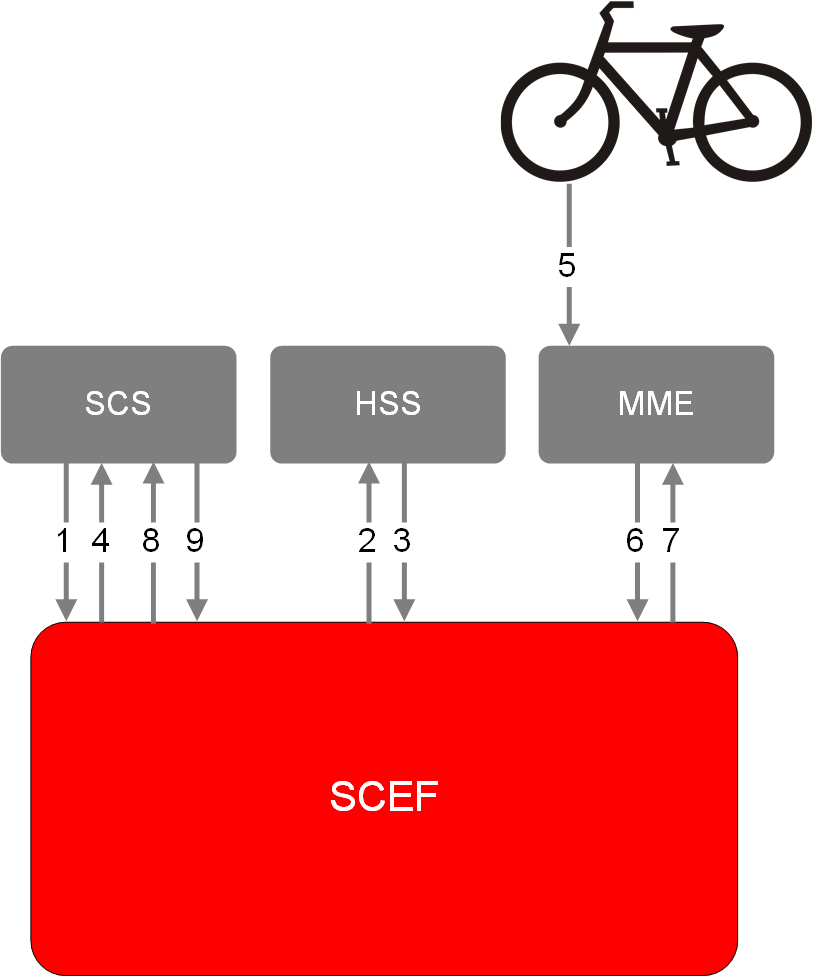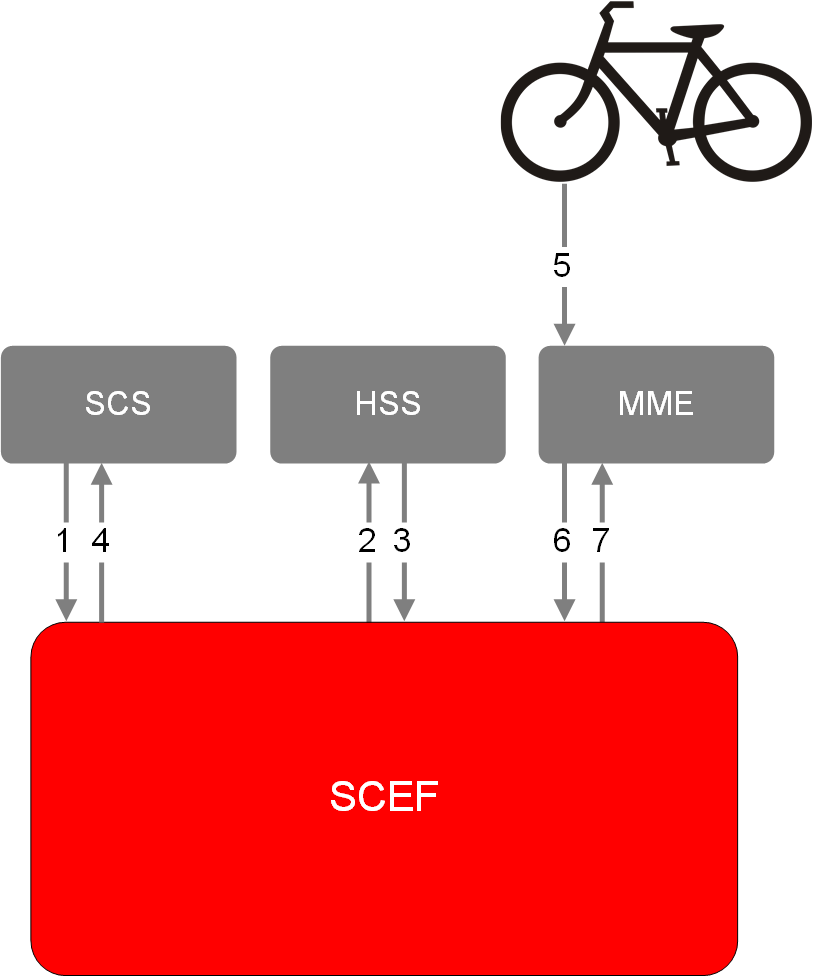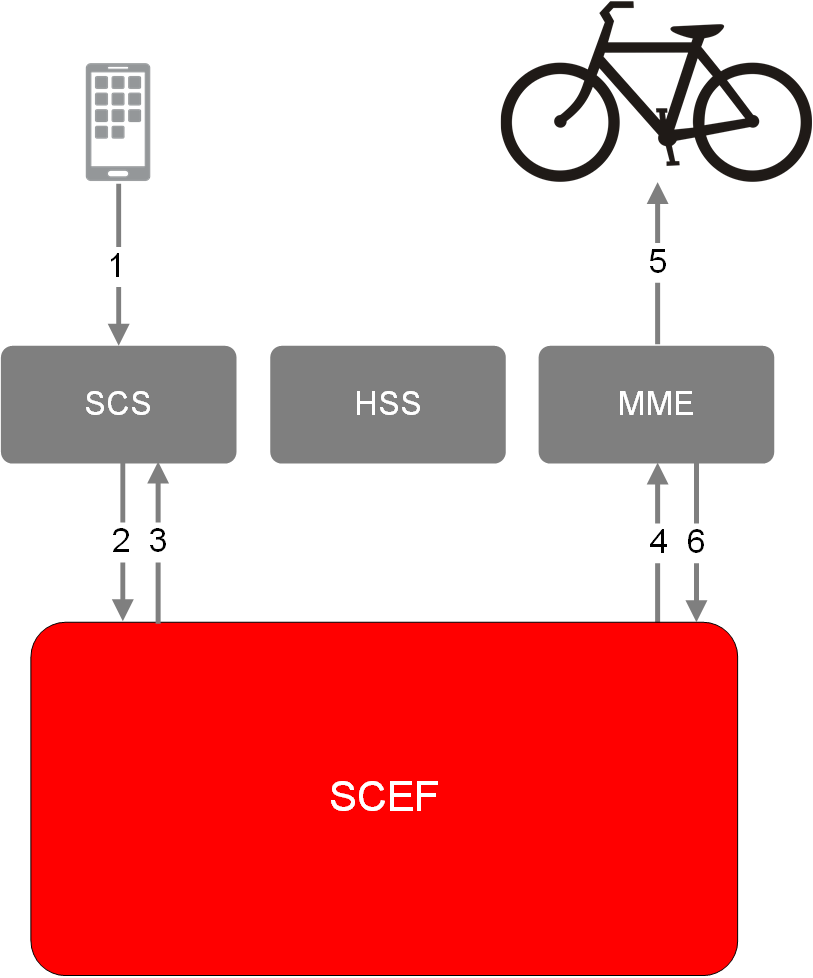The SCEF server establishes service flows between IoT devices and external functions that provide subscriber services. This use case is an overview of how the Policy Management system could implement a bicycle-sharing service, focusing on the role of the SCEF server in general terms and also in terms of Diameter message flow.
- Service exposure—The bicycle transmits its physical location
- Service configuration—The bicycle is configured for connectivity and is onboarded, and can then be displayed on a subscriber's mobile application
- Service start—The subscriber unlocks the bicycle using the mobile application, and then rides the bicycle to a destination
- Service end—The subscriber locks the bicycle at the destination
Service Exposure
The shared-bicycle business center uses a services capability server (SCS) to configure each bicycle, which is a NarrowBand IoT (NB-IoT) device, for location reporting. Once configured, each bicycle reports its physical location to a mobility management entity (MME). (This is a one-time operation.) One the bicycle's location is established, a subscriber's mobile application can display the bicycle's location by communicating with a home subscriber server (HSS). As illustrated in Figure 1, the following actions occur:

- The SCS sends an onboarding Configuration on Monitoring Event (Location Reporting) request to the SCEF server.
- The SCEF server triggers a Diameter S6t Configuration Information Request (CIR) message to the HSS.
- The HSS sends a Diameter Configuration Information Authentication (CIA) response message to the SCEF server.
- The SCEF server sends a Configuration Confirmation message, indicating successful onboarding, to the SCS.
- The bicycle (NB-IoT device) reports its current location to the MME.
- The MME sends a Diameter T6a Reporting Information Request (RIR) message to the SCEF server to report the location of the NB-IoT device.
- The SCEF server authenticates the request and acknowledges the request to the MME.
- The SCEF server delivers the RIR message to the SCS.
- The SCS acknowledges the request to the SCEF server.
Service Configuration
The SCS configures the NB-IoT device for connectivity and triggers the SCEF server for onboarding. The NB-IoT device establishes a connection with the network for data exchange, using mobile terminated non-IP data delivery (MT-NIDD).

- The SCS sends a T8 onboarding NIDD Configuration Request to the SCEF server.
- The SCEF server triggers a Diameter S6t NIDD Information Request (NIR) device authentication message to the HSS.
- The HSS sends a Diameter NIDD Information Authentication (NIA) response message to the SCEF server.
- The SCEF server sends an NIDD Configuration Confirmation message, indicating successful onboarding, to the SCS.
- The bicycle (NB-IoT device) sends an NIDD Connectivity Request to the MME.
- The MME sends a Diameter T6a Connection Management Request (CMR) message to the SCEF server.
- The SCEF server identifies the NB-IoT device as valid, authenticates the request, and acknowledges the request with a Diameter Connection Management Answer (CMA) message to the MME.
Service Start
Using the mobile application, the subscriber obtains the NB-IoT device location information from the HSS and goes to the bicycle. The subscriber uses the mobile application to trigger the SCS to unlock the bicycle using mobile terminated non-IP data delivery (MT-NIDD). (Unlocking is a routine and repeated operation.) As illustrated in Figure 2, the following actions occur:

- The mobile application uses the NIDD connection to send mobile-terminated (MT) downlink data to the SCS.
- The SCS sends a request (NTR) message with the data to the SCEF server.
- The SCEF server sends an acknowledgment (NTA) message to the SCS.
- The SCEF sends a Diameter T6b MT Data Request (TDR) message with the data to the MME.
- The MME sends mobile-terminated (MT) downlink data to the NB-IoT device.
- The MME sends an acknowledgment (TDA) message to the SCEF server.
Service End
The subscriber rides the bicycle to a destination and manually locks the bicycle. (Locking is a routine and repeated operation.) The NB-IoT device establishes a connection with the network for data exchange, using mobile originated non-IP data delivery (MO-NIDD), to report the updated lock status. As illustrated in Figure 4, the following actions occur:

- The NB-IoT device uses the NIDD connection to send mobile-originated (MO) uplink data to the MME.
- The MME sends a Diameter T6a MO Data Request (ODR) message with the data to the SCEF server.
- The SCEF server identifies the NB-IoT device as valid, authenticates the request, and delivers the data to the SCS.
- The SCEF server sends a Diameter response to the MME indicating successful data delivery.